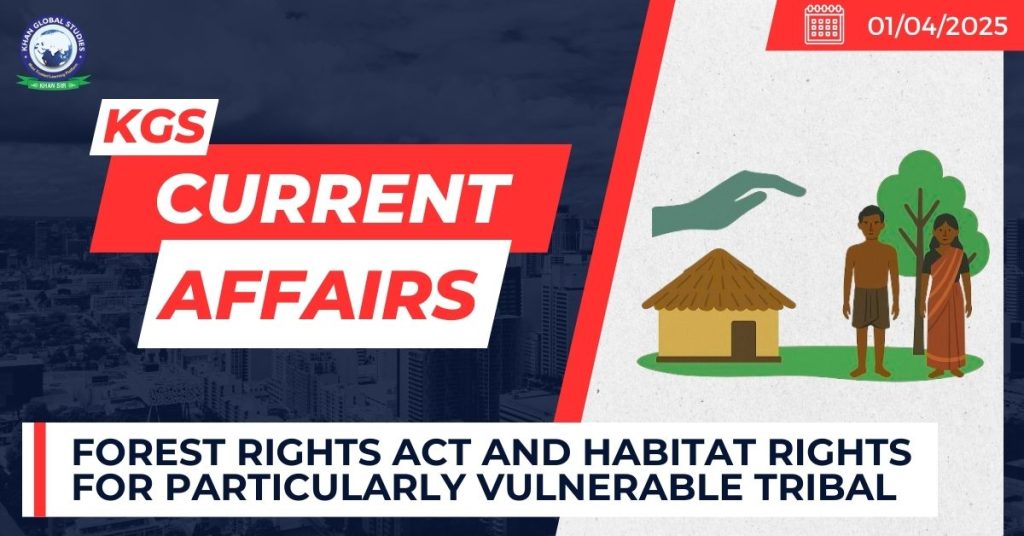Context:
Over 25 years since the Forest Rights Act (FRA) of 2006 came into effect, only 10 PVTGs have been granted habitat rights across 14 districts in three States (Odisha, Madhya Pradesh, and Chhattisgarh), as revealed by the government in Parliament.
More on the News
- This information is provided by the Ministry of Tribal Affairs in response to a query from the Tiruvallur Congress MP, who raised concerns about the misinterpretation of the term “habitat” in the law and the displacement of PVTGs due to mining and development activities.
- The Minister of State for Tribal Affairs clarified that land and its management fall under the state government’s purview, so the ministry does not have specific data regarding the displacement of PVTGs due to mining or developmental activities.
Internal Panel’s Findings:
- In December 2020, an internal panel led by former Tribal Affairs Secretary Hrusikesh Panda highlighted persistent issues in granting habitat rights to PVTGs.
- The panel identified that many habitats within proposed mining areas and sanctuaries are “not seen as worth recognising” because the officials responsible for settling habitat rights often hold concurrent responsibilities for these projects.
- A misinterpretation of “habitat” as “awaas” (housing) in Hindi led officials to confuse habitat rights with housing rights, ignoring the broader cultural and traditional habitat needs of PVTGs.
Particularly Vulnerable Tribal Groups (PVTG) communities
In 1975, the Government of India created a separate category called PVTGs (on the recommendation of the Dhebar Commission) out of Schedule Tribes and declared 52 such groups, while in 1993, an additional 23 groups were added to the category, making it a total of 75 PVTGs.
According to the 2011 Census, the 75 PVTGs reside in 18 States and UT of A&N Islands, with a total population of approximately 45.56 lakh.
- Orissa has the highest (13) number of them.
The PVTG of Sahariyas has the highest population, whereas the PVTGs of Sentineles and Andamanese have a very small population.
The government of India follows the following criteria for the identification of PVTGs:
- Pre-agricultural level of technology
- Low level of literacy
- Economic backwardness
- A declining or stagnant population.

About Scheduled Tribes and Other Traditional Forest Dwellers (Recognition of Forest Rights) Act, 2006
- The Forest Rights Act (FRA), 2006 recognizes the rights of the forest-dwelling tribal communities and other traditional forest dwellers to forest resources, on which these communities were dependent for a variety of needs, including livelihood, habitation and other socio-cultural needs.
Definition of Habitat:
- Under Section 2(h) of the FRA, “Habitat” refers to areas traditionally inhabited by primitive tribal groups and pre-agricultural communities, including their customary habitats and other areas with community rights in reserved, protected, and other forests.
- A 2015 government directive clarified that community tenure rights over habitat can be recognized in customary territories used by PVTGs for livelihood, social, cultural, and other purposes. These habitats may sometimes overlap with other forest rights.
Rights Granted to Forest Dwellers Under the FRA:
- Land Right: Forest dwellers have the right to hold and live in the forest land under the individual or common occupation for habitation or self-cultivation for livelihood, with a maximum limit of 4 hectares per family.
- Use Rights: Right of ownership, access to collect, use, and dispose of minor forest produce traditionally collected within or outside village boundaries.
- Minor Forest Produce includes all non-timber forest produce of plant origin such as bamboo, brushwood, stumps, cane, tussar, cocoons, honey, wax, lac, tendu or kendu leaves, medicinal plants, herbs, roots, etc.
- Title Rights: Rights for conversion of Pattas or leases or grants issued by any local authority or State Government on forest lands into titles.
- Right to Protect and Conserve: Rights to protect, regenerate, conserve, or manage any community forest resource which they have traditionally protected and conserving for sustainable use.
- Right to Access: Right of access to biodiversity and community’s right to intellectual property and traditional knowledge related to biodiversity and cultural diversity
- Heritable Rights: However, all such forest rights are heritable but not alienable or transferable. The rights will be jointly registered in the name of both the spouses in case of married persons, and in the name of the single head in the case of a household headed by one person.
Recognition of Forest Rights: Section 6 of the Act provides a transparent three-step procedure for deciding forest rights.
- Gram Sabha Initiation: To initiate the process for determining the nature and extent of individual or community forest rights within its jurisdiction and thereafter forward a copy of the same to the Sub-Divisional Level Committee.
- The Sub-Divisional Level Committee: This committee examines the Gram Sabha’s resolution, prepares the record of forest rights, and forwards it to the District Level Committee for a final decision.
- The District Level Committee: The District level Committee makes the final decision on the record of forest rights, and its decisions are final and binding.
- The State Level Monitoring Committee: It oversees the process to ensure the proper recognition and vesting of forest rights.
Composition of the Committee:
The committees at the Sub-Divisional Level, District Level and State Level shall consist of:
1. Three govt officials from the department of Revenue, Forest and Tribal Affairs of the State Government and
2. Three members of the Panchayati Raj Institutions at the appropriate level, with at least two members of the Scheduled Tribe and at least one woman.

